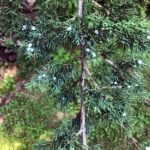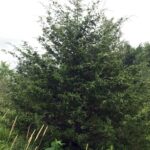Native To State: YES
Naturally Occurring: YES
Description
Juniperus virginiana (Eastern Red Cedar or Virginia Juniper) is an evergreen coniferous tree belonging to the Cupressaceae family. Here are some key identification characteristics:
Size and Shape: Eastern red cedar is a medium-sized tree that typically reaches heights of 30 to 60 feet (9 to 18 meters). It has a narrow, columnar or pyramidal shape when young, gradually becoming more irregular and spreading with age.
Leaves: The leaves of Juniperus virginiana are scale-like, opposite or in whorls of three, and arranged in flattened sprays. They are green to bluish-green and have a distinctive resinous fragrance when crushed.
Fruit: The tree produces small, fleshy, berry-like cones that are about 0.25 to 0.5 inches (6 to 13 millimeters) in diameter. These cones initially appear green but mature to bluish-purple and may persist on the tree for several years.
Bark: The bark of Eastern red cedar is reddish-brown and exfoliates in thin, fibrous strips, revealing a reddish inner layer. The exfoliating bark adds to the tree’s rustic appearance.
Habitat: Juniperus virginiana is native to eastern North America and can be found in a variety of habitats, including open woodlands, hillsides, and rocky areas. It is well-adapted to a range of soil conditions, including dry and poor soils.
Cultivation: Eastern red cedar is valued for its hardy nature and is often planted for erosion control, windbreaks, and wildlife habitat. It is also used in landscaping and as a Christmas tree.
Other Species: There are other juniper species, such as Juniperus scopulorum (Rocky Mountain juniper) and Juniperus chinensis (Chinese juniper), each with its unique characteristics.
Eastern red cedar is an ecologically important tree, providing food and shelter for various wildlife species. It is also used in traditional medicine and has cultural significance for certain indigenous communities.
Occurrence
Widespread in all areas of the property and in all stages of maturity.



